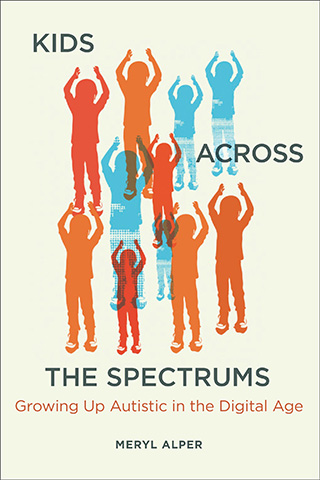Shattering Stereotypes About Autism and Technology

In spite of widespread assumptions that young people on the autism spectrum have a “natural” attraction to technology — a premise that leads to significant speculation about how media helps or harms them — relatively little research actually exists about their everyday tech use. It’s a gap Meryl Alper, a researcher exploring the social and cultural implications of communication technologies, addresses in her new book “Kids Across the Spectrums,” an ethnographic study of the digital lives of autistic young people.

Based on nearly a decade of in-depth qualitative research conducted in the homes of more than 60 neurodivergent children from an array of racial, ethnic, and socioeconomic backgrounds, Alper challenges the prevailing myths and stereotypes that have perpetuated misconceptions about autistic youth and their relationship with technology. What Alper found is that what autistic youth do with technology is not radically different from their nonautistic peers. The experiences that children on the autism spectrum have with technology are less explained by their diagnoses alone, she writes in the book’s introduction, and more by the intersections of their disability with other aspects of their identity and the modern conditions of childhood: “They differentially face significant social and health inequalities, including limited recreational programs, poor neighborhood safety, and challenges receiving appropriate therapeutic services.” These disparities, Alper argues, “spill directly over into autistic children’s media habits.”
“Kids Across the Spectrums,” which is available in a freely downloadable open access edition, stands as a timely and deeply humane work that will especially resonate with educators, technologists, and parents of neurodivergent children, who will find insight and solace in its pages.
The MIT Press Reader: “Kids Across the Spectrums” is the result of seven years of ethnographic fieldwork and the first book-length study of autistic young people and their everyday uses of media and technology. What has enabled people to speak with authority about the relationship between autism, children, and technology when, in fact, little real-life research has been conducted?
Meryl Alper: Young people on the autism spectrum — and really, disabled people in general — regularly serve as symbols onto which non-disabled people’s values, beliefs, and concerns are projected in public discourse, while recognition of their capacity as citizens with rights and agency is actively diminished and denied. With respect to technology, autistic young people are at once transformed into an untapped workforce for driving innovation in the computer sciences, the ultimate test cases for AI-driven therapeutic interventions and diagnostic services, and irrefutable proof of the social and behavioral harms of video games and of the societal valuing of “screen time” over time spent face-to-face.
“I was pretty surprised … at how common it is for autism research to not even report the demographics of study participants.”
In “Kids Across the Spectrums,” I discuss how these myths and stereotypes arise from several directions, and why it’s vital to directly observe and discuss media use with autistic young people themselves. For one, there is a long-standing cultural association of children on the spectrum with machines and robots, both as objects of autistic young people’s fascination (e.g., gears) and as non-human entities to which they are compared (i.e., unfeeling, favoring repetition). Over the decades, this has engendered autistic young people’s dehumanization and exclusion. Their designation as a “special” or vulnerable population becomes a self-fulfilling prophecy when it comes to their omission from and invisibility within empirical studies of children, media, and technology.
Parents and medical professionals have also become de facto spokespeople for speaking and non-speaking autistic young people’s experiences with media and technology, in the absence of children on the spectrum having their own platform and robust communication tools (though this is somewhat shifting with digital and social media, as well as developments in assistive speech technologies). The loudest and most frequently amplified voices are often caregivers who have the most exceptional individual stories and clinicians/researchers making the most exaggerated claims. And lastly, it’s not easy or straightforward for neurotypical people such as myself to do ethical and responsible research with neurodivergent children, especially considering their vast differences in communication and cognition — part of why it took seven years to do research for “Kids Across the Spectrums”!
MITPR: Autism has historically been the domain of White, upper-middle-class boys. What steps did you take to ensure that your research didn’t perpetuate these biases that have influenced autism studies (and diagnoses)?
MA: My last book, “Giving Voice,” showed how technologies that are often thought of as innately liberatory (such as assistive technologies for disabled people) can fail to live up to their hype because the individuals with disabilities who might potentially use them are still subject to inequalities that are built into social systems regulating the technology (e.g., education, healthcare). Those insights were only made possible because I engaged in the purposive sampling of young people with developmental disabilities and their families from an array of racial, ethnic, and socioeconomic backgrounds (as opposed to a convenience sample of the first people to answer my recruitment ads).
With respect to autism, even “representative” studies are flawed because no one really knows the true national or global incidence rate of autism (nor is there universal consensus on the best way to define “autism”). What is well understood is that girls, rural and low-income children, and non-White kids have historically been undercounted in autism rate estimates. And yet, I was pretty surprised, coming from the field of communication studies and with methodological training in sociology, at how common it is for autism research to not even report the demographics of study participants, and to be more focused on differentiators like autism assessment scores in that work.
To ensure that I did justice to the plurality of experiences had by young people in “Kids Across the Spectrums,” I took several steps. I recruited participants through organizations and resource centers that already had trusted relationships with families. I printed out fliers and communicated with some parents via text to accommodate those without reliable home interest access. I made myself available to speak with kids and caregivers outside of regular working hours (i.e., weekends, evenings, holidays). And I showed up to in-person events for autistic children and their families in under-resourced communities.
Outside of recruitment, I benefitted from the immense generosity of autistic people who read and gave feedback on drafts of the book, in whole and in part. As a person who does not identify as neurodivergent or disabled, but whose background is in the development and design of accessible and inclusive media and technology for young people, reflecting on any potential bias that I might introduce into the analysis was and is an ongoing process in my research. As my own work evolves and expands into new projects with older youth (e.g., a study of autistic TikTok, or #autisktok), I am also tremendously grateful to have a fantastic group of neurodiverse collaborators.
MITPR: In your chapter on media representations of autism, you point out that books “seem to provide more support than other media among school-age kids on the spectrum to develop a positive autistic identity centered around self-acceptance and the acceptance of others.” That said, what could be done better in this medium? What is missing that kids are looking for and responsive to?
Meryl Alper: Mass media representation of autistic people has come very far in recent years, but it still has a long way to go to be truly inclusive, which can be said for almost all minoritized groups. Autistic digital creators and social media influencers are helping to broaden understanding of autism among neurotypical media audiences, in addition to building community for fellow autistic young people online. These worlds can also influence one another; for example, one of the most vivid and rich depictions of autism in mass media recently comes from the Netflix streaming series “Heartbreak High,” which features a character on the autism spectrum named Quinnie, played by autistic TikTok creator Chloe Hayden.
“Books for young people in the U.S. have often allowed those at the social margins to find themselves more readily within the margins of the page.”
Books for young people (or “kid lit”) in the U.S. have often allowed those at the social margins to find themselves more readily within the margins of the page, starting in the 1960s and 1970s. Books come in many formats — picture books, workbooks, graphic novels — so there are accessible entry points for children of various ages and ability levels. Books for kids featuring disabled children sometimes center non-disabled children as the main protagonist. With respect to autism, this is true for best-selling books like “Rules.” What could be done better is having more books at different grade levels with autistic children as the lead characters, and more autistic authors being published (on topics that may or may not be about autism). See, for example, Dara McAnulty’s “Diary of a Young Naturalist” or the YA books of Sarah Kapit.
MITPR: You stress that disabled children’s technology use has historically and primarily been understood through a curative or rehabilitative lens, placing more emphasis on kids that need fixing than on systems that need overhauling. What steps can be taken to shift this emphasis on a structural or even personal level?
MA: Kids with disabilities regularly appear in ads by tech companies like Microsoft and Apple to brand them as enabling, on an individual and societal level. “Feel good” news stories about funds being raised to provide disabled children with needed assistive technologies regularly get shared on social media. It isn’t that these technologies can’t be empowering or that fundraisers aren’t helpful. But if we stop short of asking if these technologies actually end up in the hands of kids with disabilities at the end of the day, or why their parents might not be able to afford the devices, or even if technology is itself the answer to the challenges that disabled kids face, then we lose sight of the bigger picture. I think this discourse shifts when complex stories like the ones that I share in my book reach many different kinds of audiences. I’ve written “Kids Across the Spectrums” to speak to parents, educators, technologists, journalists, media makers, clinicians, and policymakers (all of which includes autistic adults).
MITPR: One of the kids included in your study, Spencer, has a fascination with elevators. Capitalizing on this passion, his parents found educational benefits for Spencer by incorporating interest-driven learning at home, but this approach is not reflected in his experiences at school — in fact, he is banned from elevators entirely. Can you expand on this family’s experience and why kids on the spectrum have been overlooked as interest-driven learners when research in fact suggests that this approach is to their benefit?
MA: It is common for many autistic people (though not all) to have one or more topics that they are deeply passionate about. They may express these passions in different ways in their personal and professional lives. Surveys indicate that among young people on the spectrum, these areas include creative interests (e.g., drawing), vehicles/transportation, mechanical objects, and animals and plants. Media and technology (e.g., computers, video games, fictional TV characters) are common focused interests among autistic kids, though these also overlap significantly with the passions of neurotypical kids. While the subject matter may not differ all that much, perceptions of the social appropriateness and value of these passions and their expression vary significantly. The same phenomenon is often framed as “interest-driven” learning when it is neurotypical kids but problematic “restricted interests” when it comes to neurodivergent kids.
When I met 4-year-old Spencer, he had educators who only saw his passions for elevators as a problem, which was at odds with how his parents perceived his interests and their potential role in his education. His mom Rosie talked about elevators as though they were a kind of companion to Spencer (an only child); he incorporated them into his pretend play at every opportunity using materials at hand, be it Play-Doh or old computer speakers (which make great pretend sliding doors). It wasn’t as if Spencer’s passion couldn’t be a problem at times. For example, Rosie discussed how she and her husband would take him to ride the elevators at the local Boston airport, but that when they’d get to the last terminal, Spencer would have a tearful meltdown.
“Race and racism play an undeniable role in how the behaviors of Black neurodivergent boys are classified as deviants and regulated as such.”
As luck would have it, Spencer’s school also had elevators. While this could have been an opportunity to connect elevators with any number of lessons and activities, his teachers banned him from having any interaction with them; perhaps due to their potential as a distraction, or the extra effort it would take to customize the curriculum for Spencer. I couldn’t help but wonder that perhaps part of why Spencer’s teachers saw his focused interest as a problem was also due to the fact that he was a Black boy in a very White, working-class part of the state. Race and racism play an undeniable role in how the behaviors of Black neurodivergent boys are classified as deviants and regulated as such.
MITPR: Is there anything else you want our readers to know?
MA: “Kids Across the Spectrums” is available for free digitally thanks to the MIT Press’s Open Access program! I take the time to explain concepts in an accessible way in the book, so it’s my hope that it reaches the widest possible audience. If you know someone in your life who might benefit from reading it, please share this article.
Meryl Alper is Associate Professor of Communication Studies at Northeastern University. She is the author of “Digital Youth with Disabilities,” “Giving Voice,” and “Kids Across the Spectrums.”



